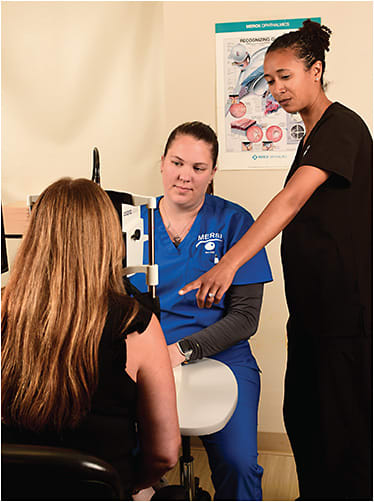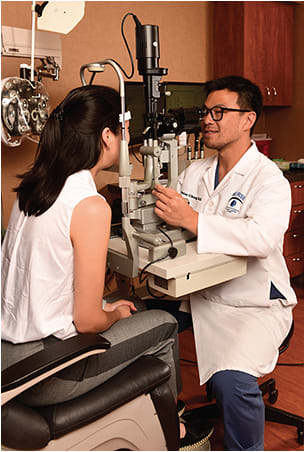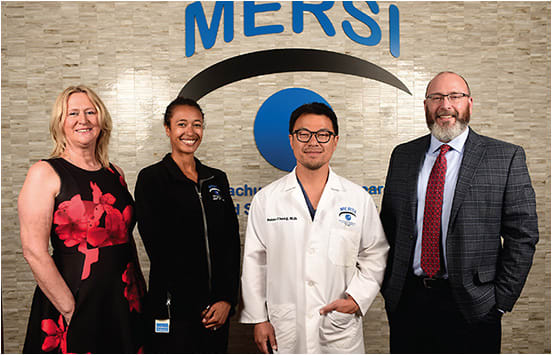PHOTOGRAPHY BY ERIC ANTONIOU PHOTOGRAPHY

It may be no coincidence that Massachusetts Eye Research & Surgery Institution (MERSI) is in Waltham, MA, the same town as the historical Waltham Watch Factory. After all, MERSI staff have a zeal for time — not wasting it, that is.
Here, the members of practice’s retina staff discuss the eight action steps they’ve taken to establish efficiency.
1. Cross-training staff
Peter Y. Chang, MD, a partner, and retina specialist at MERSI, says that to help ensure a punctual work schedule, staff are required to go through training for every allied health position; this entails training on every new technology the practice incorporates as well.
“Having staff members trained to do each other’s jobs allows for them to jump in when another staff member calls in sick or something unforeseen, such as a change in a doctor’s surgery schedule, occurs,” he explains.
Kayla Moses, COA, the practice’s manager of ophthalmic technicians, adds that the practice’s fellows also lend a hand. For example, they can pick up a patient from check in, chart, and perform diagnostic testing.
All MERSI technicians learn testing first during a walk-through with a more senior tech, usually Ms. Moses. Then, they practice the testing on other staff who volunteer when the patient schedule is light, she explains. Finally, techs perform the testing on patients with supervision until their supervisor signs off on their training. “We prioritize training in order from most to least common tests, beginning with optical coherence tomography (OCT), then fundus photos, fluorescein angiogram, and then B-scan,” Ms. Moses points out.
One frequently occurring example illustrates the benefits of this training: “If all retina-assigned techs are busy with patients and another retina patient needs testing, a tech who is helping in a clinic that is less busy might jump in to quickly perform the testing for the patient — especially if it is a quick test like OCT or B-scan,” says Ms. Moses.
2. Charting required testing/injections
Dr. Chang and fellow retina specialist Peter L. Lou, MD, help establish schedule efficiency by charting the patient testing needed for follow-up appointments. “This has enabled staff to schedule patients accordingly and ensure the testing device is ready upon the patient’s visit,” Ms. Moses says. “Before, the established patient would often see the doctor in the exam room first and then a tech would take the patient for the needed follow-up testing. This approach often created wait times for both the patient and the doctor.”
Regarding anti-VEGF injection appointments, staff chart prior authorization approval, injection type, injection history, and frequency prior to such appointments, adds Dr. Chang.
“A lot of our patients spend their winters in Florida and return to MERSI in the summer, wanting to keep receiving their injections for, say, age-related macular degeneration,” he explains. “Knowing this information in advance allows for their injections to be made readily available during the appointment instead of learning about this information during the appointment.”

3. Repositioning equipment and supplies
As all retina patients require an OCT scan prior to seeing Drs. Chang and Lou, and retina patients can have mobility issues, the OCT room was moved from beyond the exam rooms to on the way to them, Dr. Chang says.
“We determined that having the OCT room farther down the hallway made travel for patients difficult, which hindered patient flow,” he acknowledges. “Now, patients don’t have to move unnecessarily, which makes them more comfortable, and no time is being wasted. We are lucky that our office layout allows for getting most of our retina imaging tests and equipment in the front of the exam area.”
For smooth patient flow and time savings for staff, samples and coupons are located on the way to check out, as these are best obtained at the end of the patient’s appointment, says Ms. Moses.
An emphasis on efficiency has also resulted in new purchases: When the practice determined that lack of equipment created patient bottlenecks, management purchased additional retina diagnostic devices, such as OCT, notes Ferida Tadic, MERSI’s director of operations.
4. Dilating before the exam
MERSI staff dilate patients sooner rather than later during the workup process, says Ms. Moses.
“Staff check the patient’s IOP first and then dilate, so that by the time they are finished with the workup, Dr. Chang can start examining the patient,” she explains. “When I started here, most techs performed dilation at the end of the workup flow, after updating medical history and checking vision and pressure. Once instilled, the dilation drops take an additional 10 to 15 minutes to set in before the retina patient can be viewed by the doctor. So, in a fast-paced practice, these minutes can set the doctor behind — and cause both the doctor and the patient to wait unnecessarily.”

MASSACHUSETTS EYE RESEARCH & SURGERY INSTITUTION
- Founded: 2005
- Examples of retina equipment used: Heidelberg Spectralis HRA+OCT, Topcon Triton DRI OCT, Accutome B-scan Plus
- Doctors: 4 MDs
- Allied health staff: 9(including fellows)
- Business office and call center: 9 (includes 3 billing)
- Front desk: 2
- Surgery coordinators: 2
- Technicians: 10
- Directors/managers: 5
5. Providing same-day injections
To maintain an efficient schedule, Drs. Chang and Lou try to provide same-day injections should they, for example, identify macular edema during an appointment, according to Ms. Moses.
“They alert a billing person, who then contacts the patient’s insurance company to determine whether the injection can be covered on the same day as the appointment,” Ms. Moses says. “If it’s a ‘yes,’ the front desk staff person prints out the patient consent form, the patient signs it, and a tech readies the injection for the doctor, so he can take care of it right after the full examination.”
With the old protocol, Ms. Moses notes that the patient was physically sent to the surgical coordinator’s office to speak with the coordinator regarding insurance coverage for the procedure and to sign the required consent form. If the surgical coordinator was busy or had other patients waiting, then the patient would need to wait to speak to her.
“By utilizing additional staff in billing and having our staff serve as the messenger to find out whether the procedure is covered, this saves the patient time and effort in ultimately getting the procedure done,” says Ms. Moses.
6. Administering subconjunctival anesthesia
The practice has hit upon another way to make injections more efficient: Dr. Chang provides subconjunctival anesthesia.
“Subconjunctival anesthesia takes just a few minutes to effectively numb the patient, and there’s minimal exposure to the cornea, so patients don’t even feel it after their injection,” he explains. “This is far faster and easier than having a staff member consistently apply uncomfortable numbing drops until the patient says they’re numb. Also, this action step frees up resources, as staff members can be utilized elsewhere.”
Dr. Chang adds that, typically, several injection patients are scheduled back-to-back, so he can go from room to room providing injections in between providing the subconjunctival anesthesia — another way to prevent time waste.

7. Providing patient education material
After the retinal patient’s first visit, MERSI staff provide patient education material on their diagnosis and prescribed treatment to reinforce what was explained and to maintain the patient schedule at follow-up visits, says Dr. Chang. “The American Society of Retina Specialists has patient fact sheets in large print, and in English, Spanish, and Chinese on 40 retinal conditions. I print these out and hand them to patients.”
(The Retina Health Fact Sheets can be found at www.asrs.org/patients/retinal-diseases .)
8. Utilizing practice flow software
To both maintain efficiency and discover new ways of achieving it, practice staff use a HIPAA-compliant, web-based color-coded practice flow software called Visual Clinic (www.visualclinic.com ), Ms. Moses explains. (Think a high-tech version of Harry Potter’s Marauder’s Map.)
“Patients are entered into the practice flow software upon registration and become viewable by all staff via screens in each room, as well as the main hallway,” she says.
Staff are also entered into the system, Ms. Moses notes, so all staff members can see where they are needed. This helps minimize potential traffic jams and allows Ms. Moses to intervene in real time (to assist in testing, for example) to maintain the schedule.
MERSI’s CEO, Scott Evans, MBA, CMPE, points out that he, Ms. Moses, and Ms. Tadic meet monthly to scrutinize any time that trended upward in a specific room and discuss action steps staff can implement to improve that time moving forward.
“Management has determined specific times for each part of the patient visit,” he explains. “As an example, a patient is to be retrieved by a staff member from the reception room within 15 minutes of their arrival, because this has been deemed achievable. If the practice flow software shows this time has increased over the last month, we will put our heads together to find out why and come up with a solution. That could be the need to reassign staff or investing in new technology.”
Incidentally, waiting for an exam room decreased from 14 minutes in January 2022 to roughly 6 minutes as of July 2023, according to Ms. Moses.
Clocking the patient journey
The Waltham Watch Factory was known for developing machinery that created precise interchangeable parts that enabled it to become the first company to mass produce a complete watch: The Factory literally created efficient time for roughly 100 years!
It appears MERSI, located just a few blocks from the still-standing, red-brick mill complex, is carrying on the Waltham Watch Factory’s legacy. OP








